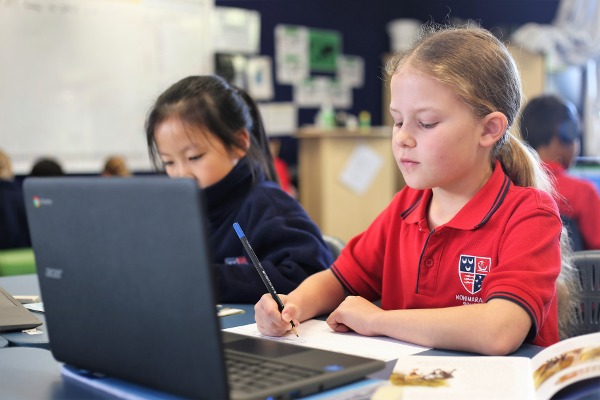Device Use
Technology and devices are part of the toolkit that supports learning and building learner agency at Kohimarama School.
This page sets out our approach to device use and how we ensure usage is both balanced and effective.
Why we have Classroom Devices and Bring Your Own Devices (BYOD)
Used in a balanced and integrated way, using a personal device delivers a number of benefits.
Deepening Learner Engagement
Our children will soon enter a workforce where the jobs they do will constantly change. To prepare them for this we need to instill in them a love of learning that they can carry with them throughout their lives. We’re achieving this through our Learner Agency approach that fosters deeper engagement and greater ownership of learning. One of the tools that enables this is SchoolTalk and students can access this on their device. It enables them to plan, track, and provide evidence of learning.
Overall the introduction of learning applications on devices has expanded the range of learning opportunities and have been shown to support students knowing about how they are meeting the learning progressions in the curriculum. We use SchoolTalk as a digital platform to be transparent with the student, the teacher and parents at home. Access is 24/7, learning is visable and this promotes learning conversations at school and at home.
Growing Digital Citizens
Digital citizenship is about instilling the values and behaviours that lead to positive and effective use of ICT. By starting to develop this from the moment a student starts using a device we’re paving the way for them to participate online in a meaningful way. Importantly we’re also preparing them for any challenges they may face online, particularly in their later school years. Our school monitors school accounts and devices to ensure strict adherance to online safely.
Getting Device Ready for Secondary School
Whether moving on to Selwyn College or another secondary school, our students will be required to have a personal device as a tool for their learning. These schools also use tools to support learner agency. For Kohimarama graduates devices won’t be a novelty, they’ll be a tool they can use effectively to support their learning from day one.
How we Balance Device Use
All device use is ‘fit for purpose’. This means that teachers will choose the most appropriate learning tool and materials depending on the task. For example, for reading students will almost exclusively read a physical book, but may complete additional follow up activities using a range of materials including a device. Another example is writing. We continue to teach handwriting and ensure sufficient practice time to meet the core requirements of the curriculum. We also use books for writing.
In terms of time on devices, a Year 3 student would be using a device on average no more than 20-30% of the time in any given week. For older students there will be occasions where this increases because of a particular project or activity. When balanced out, across a typical school week all our students will spend a significant majority of time engaging in physical and device free learning activities. It is also important to realise that in many cases even when devices are being used they are not the only component of the student’s learning – for examples groups of students may use a device for research for a project or exercise they are working on. We’re very aware of the health risks of device overuse and continue to monitor ensuring we keep the balance.
Why we Start at Year 3
In 2018 we extended the BYOD option to Year 3 students. Our belief is that this is the age where students develop a level of independence and responsibility to be able to manage their own device. It’s also an age where we can tap into their desire to take more ownership for their learning. Feedback from our teaching staff and student achievement measures has shown that students have learned to use their devices effectively for learning. They have knowledge about where they are learning, their next steps for learning and have provided evidence to demonstrate that. This also reinforces their assurance that they are successful.
How we Track the Effectiveness of Devices for Learning
Our key measure of learning effectiveness is how our students are achieving against the curriculum and our learning dispositions. As we introduce digital learning tools we closely monitor for any changes in student achievement and wellbeing. We also take into account the latest research, learnings from other schools in our community, and insights from the Ministry of Education to evolve our approach. Our goal is to continue to produce high levels of student achievement within a learner agentic environment. We’re seeing lots of examples of students extending their learning as a result of some of the tools we’ve introduced.
Safeguards and Monitoring we have in place
The main device used is a Chromebook. As Chromebooks are web-based most of the Chromebook’s documents and apps exist in “the cloud” rather than on the device itself. This means that students have to login to the Kohimarama School environment to access designated learning tools and sites. The school router settings are locked down preventing students accessing other sites or web apps. In addition, all teachers use an application called Hapara that enables real time monitoring of student device use.
Bring Your Own Devices Guidelines & Policy
We allow Year 3-8 students to bring a specific personal device, a Chromebook, to school. This is optional and we continue to provide school devices for student use throughout the school. Find out more on the Bring Your Own Device Policy Page.

